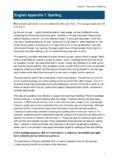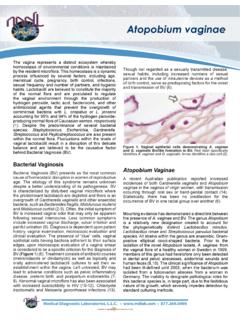Transcription of Dermatofibrosarcoma protuberans (DFSP) is a …
1 Dermatofibrosarcoma protuberans ( dfsp ) is a slowly growing, low-grade spindle cell neoplasm arising in the dermis and subcutaneous tissue. It occurs most frequently in the trunk and groin, followed by the proximal extremities and the head and neck region. This fibrohistiocytic tumor tends to recur locally but has no metastatic potential. However, recurrent and sometimes even primary dfsp can progress to more aggressive fibrosarcomatous (high-grade) dfsp , which can metastasize. Diagnostic cytomorphological features and clues to correct diagnosis: Cytological features of dfsp include tight, often three-dimensional clusters and dissociated, bland, uniform or slightly atypical spindle cells embedded in a collagenous, occasionally metachromatic matrix (visible in MGG staining). Tumor cells have often poorly defined cytoplasmic borders and bare nuclei dispersed in the background are frequent finding.
2 The nuclei of the spindle cells are fusiform and ovoid or round with finely dispersed chromatin, showing occasional, mild anisokaryosis and irregular borders. Some of the spindle cells have somewhat better defined cytoplasm with bipolar cytoplasmic processes. Occasionally an admixture of moderately pleomorphic spindle cells and a few multinucleated cells may occur as well as fragments of collegenous threads. Storiform pattern is relatively frequent seen in the cell clusters while entrapped fat tissue, one of the most diagnostic patterns of histological sections, is an infrequent finding in FNA smears. However, a storiform pattern is not exclusive to smears of dfsp , and may be occasionally observed in other spindle cell lesions such as nodular fasciitis, fibrous histiocytoma, and solitary fibrous tumor.
3 It is important to point out that the characteristic histological features of dfsp can be readily appreciated in slides from cell blocks prepared from aspirated material. Spindle cells in dfsp are positive for CD34. Differential diagnosis: Spindle cell lipoma (SCL), nerve sheets tumors, nodular fasciitis (NF), fibrous histiocytoma (FH), solitary fibrous tumor (SFT), synovial sarcoma, fibrosarcoma. SCL is a benign neoplasm that displays monomorphic spindle cells mixed with fat and collagenous fibers in smears. SCL containing predominantly spindle cells may be difficult to distinguish from dfsp , as the spindle cells in both entities have a similar morphology and immunohistochemical profile. An important clue is the presence of brightly staining fragments of collagen matrix, frequently found in smears from SCL.
4 The clinical presentation is also helpful in differentiating these two tumors. SCL is typically located in the subcutaneous tissue of the back, neck or shoulder in men over 40. NF in its late stage yields a population of very monomorphic cells arranged in cell-clusters or dissociated cells similar to dfsp . Late NF is almost indistinguishable from dfsp in routinely stained smears. Some inflammatory cells and ganglion-like cells can usually be identified, however. The clinical appearance of NF is different from that of dfsp , as NF is a rapidly growing and in most cases spontaneously regressing lesion. Immunostaining with CD34 and smooth muscle actin (SMA) are also of help in differentiating dfsp from NF. Smears from benign tumors of neural origin such as schwannoma and neurofibroma, which can show morphologic overlapping with dfsp constitute other differential diagnoses.
5 It is important to have access to immunocytochemistry, which can easily distinguish between fibrohistiocytic and neurogenic spindle cell tumors as cells aspirated from benign nerve sheets tumors display positivity for S-100 and are negative for CD34. Smears from FH, especially the cellular variant, can be easy confused with dfsp . Cellular FH presents often as a relatively rapidly-growing (months) mass with a predilection for the limbs, head and neck, which is different from dfsp . Identification of plump histiocytes and giant cells , as well as negative staining for CD34 and positive for alpha smooth-muscle actin in most cases, helps to exclude dfsp . Smears from a SFT show cytologic and immunohistochemical patterns similar to dfsp . Compared to most dfsp , SFT is more deeply located and usually does not involve the dermis.
6 Synovial sarcomas, especially the monophasic fibrotic subtype, yield cellular smears with poorly cohesive clusters and dissociated bland-looking spindle cells similar to dfsp . cells aspirated from synovial sarcoma are positive for CD99 and focally positive for EMA and keratin, but negative for CD34. Cytogenetic and molecular analysis of aspirated material may be also of help, since most synovial sarcomas show an X;18 translocation. References 1. Siddaraju N, Singh N, Murugan P, Wilfred CD, Chahwala Q, Soundararaghavan J: Cytologic diagnostic pitfall of Dermatofibrosarcoma protuberans masquerading as primary parotid tumor: a case report. Diagn Cytopathol 2009, 37(4):277-280. 2. Tsang AK, Wong FC, Ng PW, Loke SL, Tse GM: Fine needle aspiration cytology of Dermatofibrosarcoma protuberans in the breast: a case report.
7 Pathology 2005, 37(1):84-86. 3. Domanski HA: FNA diagnosis of Dermatofibrosarcoma protuberans . Diagn Cytopathol 2005, 32(5):299-302. 4. Klijanienko J, Caillaud JM, Lagace R: Fine-needle aspiration of primary and recurrent Dermatofibrosarcoma protuberans . Diagn Cytopathol 2004, 30(4):261-265. 5. Zee SY, Wang Q, Jones CM, Abadi MA: Fine needle aspiration cytology of Dermatofibrosarcoma protuberans presenting as a breast mass. A case report. Acta Cytol 2002, 46(4):741-743. 6. Domanski HA, Gustafson P: Cytologic features of primary, recurrent, and metastatic Dermatofibrosarcoma protuberans . Cancer 2002, 96(6):351-361. 7. Filipowicz EA, Ventura KC, Pou AM, Logrono R: FNAC in the diagnosis of recurrent Dermatofibrosarcoma protuberans of the forehead. A case report. Acta Cytol 1999, 43(6):1177-1180.
8 8. Fukushima H, Suda K, Matsuda M, Tanaka R, Kita H, Hanaoka T, Goya T: A Case of Dermatofibrosarcoma protuberans in the Skin over the Breast of a Young Woman. Breast Cancer 1998, 5(4):407-409. 9. Kocjan G, Sams V, Davidson T: Dermatofibrosarcoma protuberans as a diagnostic pitfall in fine- needle aspiration diagnosis of angiosarcoma of the breast. Diagn Cytopathol 1996, 14(1):94-95.


![Erasmus 2012 benign liver [Alleen-lezen]](/cache/preview/f/e/e/4/a/7/9/5/thumb-fee4a79576c8f0c73b18d46f7a40e343.jpg)




